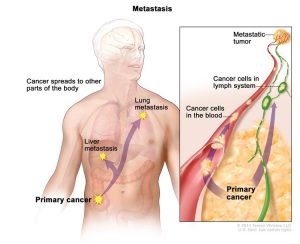The purpose of this assignment is to explain to laymen a non-relative term.
Students in the college have biology lesson about cancer biology and one of the definition which they will often meet are metastasis. A teacher assistant tries to explain this term by giving different types of definition and elucidating its main evolution steps.
What is Metastasis?
Parenthetical Definition: Metastasis (metastatic disease or metastatic tumor) is the spread of tumor from one organ, where it was originate, to another body site.
Sentence Definition: Metastasis the process of dissemination of cancer cells from its primary site to different, nearby or distant, parts of the body usually through blood or lymphatic systems, where malignant cells∗ form a “new” secondary tumor.
Expanded Definition: Metastasis is the movement of tumor cells from its initial location (primary tumor) to other parts of the body through the bloodstream, lymphatic system or by direct invasion into surrounded tissues∗, where malignant cells form a “new” secondary tumor. Metastatic tumor belongs to the same type of cancer as the original tumor. For example, if lung cancer spreads to the brain, the tumor cells in the brain are cells of lung cancer, not brain cancer cells. Metastasis is considered one of the hallmarks of cancer (1) and at the same time, is the major contributor to the deaths of patients with cancer. For instance, in Canada cancer is the leading cause of death and prevails over other leading causes of death, such as heart and cerebrovascular (i.e. stroke) diseases∗.
The term metastasis was first mentioned in the 1580s from a conjugation of the Greek prefix “meta” (change, alteration) and “stasis” (an equilibrium condition). But this term was neglected for years and widely started to use again just in the 20th century with the development of oncology.
The process of metastasis includes several steps, which is known as the invasion-metastasis cascade (see Figure 1). Firstly, to metastasize the group of malignant cells should acquire the ability to leave the primary site and move elsewhere to the distant body organs. As was mentioned previously, for spreading cancer cells use two main pathways: the lymphatic pathway, which leads to the invasion of the lymph nodes (organs of lymphatic and immune systems, which act as filters for foreign particles, including cancer cells) closest to the organ where the tumor originated. The second route is the blood pathway, leading to the invasion of distant organs, mostly lung, bone, liver or brain. Tumor cells, circulating in blood or lymphatic system, evade the immune system through various mechanisms. The migration of tumor cells mostly unpredictable. To invade cancer cells need to adhere to the wall of the blood vessel and then they migrate through it. Finally, getting into another tissue cancer cells start to grow and form a colony. This is the final phase in the malignant tumor progression (4).
The treatment of metastatic tumors is the most challenging goal in modern clinical oncology (the branch of medicine which studies cancer) and directs to prolong survival, maintain quality of patients` life and prevent other problems caused by metastases.

Figure 1. Illustration of the metastasis process. https://www.cancer.gov/publications/dictionaries/cancer-terms/def/metastasis. Accessed September 24, 2019.
Glossary
Cerebrovascular diseases: a group of diseases, that affect blood vessels and blood supply of the brain.
Malignant cells: cancerous cells, which divide and grow uncontrollably, and prompt to spread to other organs.
Tissue: a group or layer of cells that perform specific functions (i.e. muscle tissue).
Work cited list:
- Douglas Hanahan and Robert Weinberg. The hallmarks of cancer. Cell. 2000.
- Canadian Cancer Statistics Advisory Committee. Canadian Cancer Statistics 2019. Canadian Cancer Society. 20
- Danny Welch, Douglas Hurst. Definning the hallmarks of metastasis. Cancer Research. 2019.
- Arthur Lambert, Diwakar Pattabiraman and Robert Weinberg. Emerging Biological Principles of Metastasis. Cell. 2016.
Leave a Reply